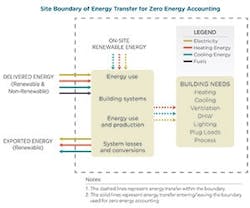Understanding Zero Energy Buildings
There’s more to verifying zero energy buildings than just noting that renewable energy production offsets annual consumption requirements. The definition of “zero energy” differs between regions and organizations, creating confusion over exactly which buildings have truly earned the moniker.
A new report by the DOE, A Common Definition of Zero Energy Buildings, seeks to bring building owners, FMs, government agencies and other stakeholders onto the same page regarding zero energy targets. “A commonly accepted definition and corresponding methods of measurement would also have a significant impact on the development of design strategies for buildings and help spur market uptake of such projects,” the DOE adds.
To properly determine which buildings qualify as zero energy, the research team had to answer these questions:
What is the site boundary? This represents a meaningful boundary of all areas that are functionally part of the building. This is usually the property boundary, but could be restricted to just the building boundary if the on-site renewables are located within its footprint. The site boundary must include the point of utility interface and encompasses all on-site renewables, all energy that is delivered to the building or exported from it, and all energy consumption and production within the building.
How is energy accounted for and measured? Certifying a zero energy building requires a thorough understanding of all energy delivered to the building and exported to the grid on an annual basis. “A zero energy building may only use on-site renewable energy in offsetting the delivered energy,” the report explains. “Renewable fuels delivered to the site boundary are not included in this term because they are treated as delivered energy to the building. For example, wood chips or biofuel harvested on-site would be considered on-site renewable energy, while wood or biofuel delivered to the site would not.”
How is source energy calculated? “Most building managers are familiar with site energy, the amount of energy consumed by a building as measured by utility meters,” the report explains. “Site energy … does not tell the whole story of impacts from resource consumption and emissions associated with energy use.” Site energy consumption is an especially poor metric for buildings with multiple energy types, on-site generation or co-generation units,” the report explains.
To determine the full impact of all energy use, all types of energy must be converted into equivalent units of raw fuel consumed in generating one unit of energy that is consumed on-site. The report offers a source energy conversion factor so that all sources from imported grid electricity to natural gas, steam, and water can be factored into zero energy accounting.
To learn more about how buildings qualify as zero energy, visit energy.gov.
